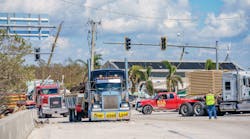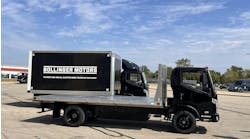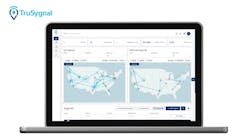Hurricane Ian wreaked havoc on the East Coast last week, begging the question of how the Category 4 storm would impact already-strained supply chains—but an analysis from DAT Freight & Analytics says that the national freight market should remain stable—even with freight rates rising as capacity shifts to other markets in the Southeast.
“If this was Houston, San Antonio … New Orleans, like a real Gulf Coast event, it absolutely would move the national needle,” Principal Industry Analyst Dean Croke of DAT told FleetOwner. In contrast, the places affected by Hurricane Ian are “relatively small freight markets,” he said, that have a higher volume of inbound loads than outbound loads.
“The polar vortex,” Croke said, referring to the series of winter storms in early 2021 that devastated the nation’s freight networks, “we never recovered from that crunch of capacity for that two-week period. I don’t know that this will do that.”
Croke said he expects inbound freight rates into Florida markets, such as the most heavily impacted market Lakeland, to stay elevated above outbound rates for at least four to six weeks. As carriers move freight into Florida, they will have to increase rates to account for miles spent deadheading out of the state, as crippled infrastructure means fewer goods are being produced and shipped outward.
See also: Spot rates continue slide in August despite stronger volume
Jason Miller, an associate professor of supply chain management at Michigan State University, wrote a similar analysis on the university’s website, stating, “The price of shipping via truck into the impacted areas of Florida will tend to increase much more than outbound transportation prices since impacted areas see a temporary decrease in outbound freight activity. Unlike with Harvey in 2017 that hit Texas and Louisiana, Florida isn't a large manufacturing state, so we shouldn't expect to see the same degree of disruption to sectors such as chemical manufacturing that we saw in 2017.”
Hurricane-related freight rates
When Hurricane Harvey struck Texas in August 2017, Croke said, inbound rates stayed 40 cents per mile higher than outbound rates for six weeks in Houston. He added that Florida, as a whole, already imports more freight than it exports, whereas Houston is a more equitable market.
According to DAT data, the average linehaul rate out of Florida increased by seven cents to $1.20 per mile, excluding fuel surcharges, after having dropped for three weeks prior. Inbound volume into Lakeland was up only 1% last week, but much more volume is expected this week as construction and emergency supplies continue to flow into the state.
Linehaul rates outbound from Atlanta and Savannah, Georgia, two markets that supply large freight volumes into Florida, increased by 3 cents and 8 cents per mile, respectively. Spot rates in both markets had been decreasing for the three weeks prior to the hurricane.
Many owner-operators will choose to stay regionally in other markets, Croke said, citing an example of a driver who last week moved watermelons out of Florida to Cleveland and is staying in that area until the worst of the damage clears.
“Florida is generally an area that carriers avoid even in good times because of the imbalance of freight, the amount of deadheads, it’s hit or miss,” Croke said. “There’s still a lot of capacity in the market that will get soaked up by the demand.”
Croke said that, in terms of capacity, “the broad market is slightly over-supplied. There’s been a lot of talk about the industry losing a lot of capacity. That hasn’t happened. … You’ve got to remember, carriers are coming off one of their best years ever last year.”
After West Coast port congestion last year and concerns over a potential strike among ongoing negotiations with the International Longshore and Warehouse Union (ILWU), many containerships have moved away from the West Coast, shifting capacity to the East and Gulf Coasts. As Hurricane Ian battered the shores, most of those vessels moved out farther to sea, up to 300 miles away—a day's sailing—to avoid the storm, before spending another day to travel back to ports such as Charleston, South Carolina, and Savannah, Croke said. As they return to the ports, volume will surge, overwhelming the contract intermodal truckload market, which spills over into the spot market, shooting rates upward.
The Florida Department of Transportation waived weight and size requirements for any commercial vehicles hauling fuel, emergency equipment, services, supplies, agricultural commodities, and citrus. Hours-of-service requirements were also waived for vehicles providing emergency supplies or services. On Sept. 27, tolls along select highways in Florida were suspended.
Rates and volumes in this story are derived from a seven-day average of data posted to RateView, DAT’s truckload pricing analysis tool, which is based on $137 billion in annualized transaction data. All rates do not include fuel surcharges.





